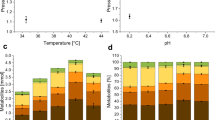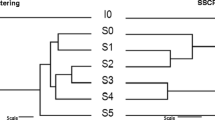Abstract
The hydrogen (H2) production efficiency in dark fermentation systems is strongly dependent on the occurrence of metabolic pathways derived from the selection of microbial species that either consume molecular H2 or outcompete hydrogenogenic bacteria for the organic substrate. In this study, the effect of organic loading rate (OLR) on the H2 production performance, the metabolic pathways, and the microbial community composition in a continuous system was evaluated. Two bacterial genera, Clostridium and Streptococcus, were dominant in the microbial community depending on the OLR applied. At low OLR (14.7–44.1 gLactose/L-d), Clostridium sp. was dominant and directed the system towards the acetate-butyrate fermentation pathway, with a maximum H2 yield of 2.14 molH2/molHexose obtained at 29.4 gLactose/L-d. Under such conditions, the volumetric hydrogen production rate (VHPR) was between 3.2 and 11.6 LH2/L-d. In contrast, relatively high OLR (58.8 and 88.2 gLactose/L-d) favored the dominance of Streptococcus sp. as co-dominant microorganism leading to lactate production. Under these conditions, the formate production was also stimulated serving as a strategy to dispose the surplus of reduced molecules (e.g., NADH2+), which theoretically consumed up to 5.72 LH2/L-d. In such scenario, the VHPR was enhanced (13.7–14.5 LH2/L-d) but the H2 yield dropped to a minimum of 0.74 molH2/molHexose at OLR = 58.8 gLactose/L-d. Overall, this research brings clear evidence of the intrinsic occurrence of metabolic pathways detrimental for biohydrogen production, i.e., lactic acid fermentation and formate production, suggesting the use of low OLR as a strategy to control them.




Similar content being viewed by others
References
Agler MT, Wrenn BA, Zinder SH, Angenent LT (2011) Waste to bioproduct conversion with undefined mixed cultures: the carboxylate platform. Trends Biotechnol 29:70–78. https://doi.org/10.1016/j.tibtech.2010.11.006
Altiok D, Tokatli F, Harsa S (2006) Kinetic modelling of lactic acid production from whey by Lactobacillus casei (NRRL B-441). J Chem Technol Biotechnol 81(7):1190–1197. https://doi.org/10.1002/jctb.1512
APHA/AWWA/WEF (2012) Standard methods for the examination of water and wastewater
Azwar MY, Hussain MA, Abdul-Wahab AK (2014) Development of biohydrogen production by photobiological, fermentation and electrochemical processes: a review. Renew Sust Energ Rev 31:158–173. https://doi.org/10.1016/j.rser.2013.11.022
Baghchehsaraee B, Nakhla G, Karamanev D, Margaritis A (2010) Fermentative hydrogen production by diverse microflora. Int J Hydrog Energy 35(10):5021–5027. https://doi.org/10.1016/j.ijhydene.2009.08.072
Berry AR, Franco CMM, Zhang W, Middelberg APJ (1999) Growth and lactic acid production in batch culture of Lactobacillus rhamnosus in a defined medium. Biotechnol Lett 21(2):163–167. https://doi.org/10.1023/A:1005483609065
Boonmee M, Leksawasdi N, Bridge W, Rogers PL (2003) Batch and continuous culture of Lactococcus lactis NZ133: experimental data and model development. Biochem Eng J 14(2):127–135. https://doi.org/10.1016/S1369-703X(02)00171-7
Bruant G, Lévesque M-J, Peter C, Guiot SR, Masson L (2010) Genomic analysis of carbon monoxide utilization and butanol production by Clostridium carboxidivorans strain P7T. PLoS One 5(9):e13033. https://doi.org/10.1371/journal.pone.0013033
Burgos-Rubio CN, Okos MR, Wankat PC (2000) Kinetic study of the conversion of different substrates to lactic acid using Lactobacillus bulgaricus. Biotechnol Prog 16(3):305–314. https://doi.org/10.1021/bp000022p
Cabrol L, Marone A, Tapia-Venegas E, Steyer J-P, Ruiz-Filippi G, Trably E (2017) Microbial ecology of fermentative hydrogen producing bioprocesses: useful insights for driving the ecosystem function. FEMS Microbiol Rev 41(2):158–181. https://doi.org/10.1093/femsre/fuw043
Caporaso JG, Kuczynski J, Stombaugh J, Bittinger K, Bushman FD, Costello EK, Fierer N, Peña AG, Goodrich JK, Gordon JI, Huttley GA, Kelley ST, Knights D, Koenig JE, Ley RE, Lozupone CA, McDonald D, Muegge BD, Pirrung M, Reeder J, Sevinsky JR, Turnbaugh PJ, Walters WA, Widmann J, Yatsunenko T, Zaneveld J, Knight R (2010) QIIME allows analysis of high-throughput community sequencing data. Nat Methods 7(5):335–336. https://doi.org/10.1038/nmeth.f.303
Carrillo-Reyes J, Celis LB, Alatriste-Mondragón F, Razo-Flores E (2014) Decreasing methane production in hydrogenogenic UASB reactors fed with cheese whey. Biomass Bioenergy 63:101–108. https://doi.org/10.1016/j.biombioe.2014.01.050
Cota-Navarro CB, Carrillo-Reyes J, Davila-Vazquez G, Alatriste-Mondragón F, Razo-Flores E (2011) Continuous hydrogen and methane production in a two-stage cheese whey fermentation system. Water Sci Technol 64(2):367–374. https://doi.org/10.2166/wst.2011.631
Davila-Vazquez G, Alatriste-Mondragón F, de León-Rodríguez A, Razo-Flores E (2008) Fermentative hydrogen production in batch experiments using lactose, cheese whey and glucose: influence of initial substrate concentration and pH. Int J Hydrog Energy 33(19):4989–4997. https://doi.org/10.1016/j.ijhydene.2008.06.065
Davila-Vazquez G, Cota-Navarro CB, Rosales-Colunga LM, de León-Rodríguez A, Razo-Flores E (2009) Continuous biohydrogen production using cheese whey: improving the hydrogen production rate. Int J Hydrog Energy 34(10):4296–4304. https://doi.org/10.1016/j.ijhydene.2009.02.063
Diekert G, Wohlfarth G (1994) Metabolism of homoacetogens. Antonie Van Leeuwenhoek 66(1-3):209–221. https://doi.org/10.1007/BF00871640
Dubois M, Gilles KA, Hamilton JK, Rebers PA, Smith F (1956) Colorimetric method for determination of sugars and related substances. Anal Chem 28(3):350–356. https://doi.org/10.1021/ac60111a017
Edgar RC (2010) Search and clustering orders of magnitude faster than BLAST. Bioinformatics 26(19):2460–2461. https://doi.org/10.1093/bioinformatics/btq461
Edgar RC, Haas BJ, Clemente JC, Quince C, Knight R (2011) UCHIME improves sensitivity and speed of chimera detection. Bioinformatics 27(16):2194–2200. https://doi.org/10.1093/bioinformatics/btr381
Etchebehere C, Castelló E, Wenzel J, Anzola-Rojas, MP, Borzacconi L, Buitrón G, Cabrol L, Carminato VM, Carrillo-Reyes J, Cisneros-Pérez C, Fuentes L, Moreno-Andrade I, Razo-Flores E, Filippi GR, Tapia-Venegas E, Toledo-Alarcón J, Zaiat M (2016) Microbial communities from 20 different hydrogen-producing reactors studied by 454 pyrosequencing. Appl Microbiol Biotechnol 100(7):3371–3384. https://doi.org/10.1007/s00253-016-7325-y
Gomes SD, Fuess LT, Mañunga T, Feitosa de Lima Gomes PC, Zaiat M (2016) Bacteriocins of lactic acid bacteria as a hindering factor for biohydrogen production from cassava flour wastewater in a continuous multiple tube reactor. Int J Hydrog Energy 41(19):8120–8131. https://doi.org/10.1016/j.ijhydene.2015.11.186
Hung C-H, Cheng C-H, Guan D-W, Wang S-T, Hsu S-C, Liang C-M (2011) Interactions between Clostridium sp. and other facultative anaerobes in a self-formed granular sludge hydrogen-producing bioreactor. Int J Hydrog Energy 36(14):8704–8711. https://doi.org/10.1016/j.ijhydene.2010.06.010
Köpke M, Held C, Hujer S, Liesegang H, Wiezer A, Wollherr A, Ehrenreich A, Liebl W, Gottschalk G, Dürre P (2010) Clostridium ljungdahlii represents a microbial production platform based on syngas. Proc Natl Acad Sci 107(29):13087–13092. https://doi.org/10.1073/pnas.1004716107
Kleerebezem R, Van Loosdrecht MCM (2010) A generalized method for thermodynamic state analysis of environmental systems. Crit Rev Environ Sci Technol 40(1):1–54
Kwok JSL, Ip M, Chan T-F, Lam W-Y, Tsui SKW (2014) Draft genome sequence of Clostridium butyricum strain NOR 33234, isolated from an elderly patient with diarrhea. Genome Announc 2(6):e01356–e01314. https://doi.org/10.1128/genomeA.01356-14
Lee J, Jang YS, Han MJ, Kim JY, Lee SY (2016) Deciphering Clostridium tyrobutyricum metabolism based on the whole-genome sequence and proteome analyses. MBio 7(3):1–12. https://doi.org/10.1128/mBio.00743-16
Milferstedt K, Santa-Catalina G, Godon J-J, Escudié R, Bernet N (2013) Disturbance frequency determines morphology and community development in multi-species biofilm at the landscape scale. PLoS One 8(11):e80692. https://doi.org/10.1371/journal.pone.0080692
Milne CB, Eddy JA, Raju R, Ardekani S, Kim P-J, Senger RS, Jin Y-S, Blaschek HP, Price ND (2011) Metabolic network reconstruction and genome-scale model of butanol-producing strain Clostridium beijerinckii NCIMB 8052. BMC Syst Biol 5:130. https://doi.org/10.1186/1752-0509-5-130, 1
Napoli F, Olivieri G, Russo ME, Marzocchella A, Salatino P (2011) Continuous lactose fermentation by Clostridium acetobutylicum—assessment of acidogenesis kinetics. Bioresour Technol 102(2):1608–1614. https://doi.org/10.1016/j.biortech.2010.09.004
Nasr N, Velayutham P, Elbeshbishy E, Nakhla G, El Naggar MH, Khafipour E, Derakhshani H, Levin DB, Hafez H (2015) Effect of headspace carbon dioxide sequestration on microbial biohydrogen communities. Int J Hydrog Energy 40(32):9966–9976. https://doi.org/10.1016/j.ijhydene.2015.06.077
Nath K, Das D (2004) Improvement of fermentative hydrogen production: various approaches. Appl Microbiol Biotechnol 65(5):520–529. https://doi.org/10.1007/s00253-004-1644-0
Noar J, Makwana ST, Bruno-Bárcena JM (2014) Complete genome sequence of solvent-tolerant Clostridium beijerinckii strain SA-1. Genome Announc. doi 2(6):e01310–e01314. https://doi.org/10.1128/genomeA.01310-14
Noike T, Takabatakea H, Mizunoc O, Ohbab M (2002) Inhibition of hydrogen fermentation of organic wastes by lactic acid bacteria. Int J Hydrog Energy 27(11-12):1367–1371. https://doi.org/10.1016/S0360-3199(02)00120-9
Nölling J, Breton G, Omelchenko MV, Kira S, Zeng Q, Gibson R, Lee HM, Dubois J, Qiu D, Hitti J, Sequencing GTC, Wolf YI, Tatusov RL, Sabathe F, Soucaille P, Daly MJ, Bennett GN, Koonin EV, Smith DR (2001) Genome sequence and comparative analysis of the solvent-producing bacterium Clostridium acetobutylicum. J Bacteriol 183:a823–4838. https://doi.org/10.1128/JB.183.16.4823
Palomo-Briones R, Razo-Flores E, Bernet N, Trably E (2017) Dark-fermentative biohydrogen pathways and microbial networks in continuous stirred tank reactors: novel insights on their control. Appl Energy 198:77–87. https://doi.org/10.1016/j.apenergy.2017.04.051
Pyne ME, Utturkar S, Brown SD, Moo-Young M, Chung DA, Chou CP (2014) Improved draft genome sequence of Clostridium pasteurianum strain ATCC 6013 (DSM 525) using a hybrid next-generation sequencing approach. Genome Announc 2(4):2–3. https://doi.org/10.1128/genomeA.00790-14
R Development Core Team R (2011) R: a language and environment for statistical computing
Rochex A, Godon J, Bernet N, Escudier R (2008) Role of shear stress on composition, diversity and dynamics of biofilm bacterial communities. Water Res 42(20):4915–4922. https://doi.org/10.1016/j.watres.2008.09.015
Saady NMC (2013) Homoacetogenesis during hydrogen production by mixed cultures dark fermentation: unresolved challenge. Int J Hydrog Energy 38(30):13172–13191. https://doi.org/10.1016/j.ijhydene.2013.07.122
Schuchmann K, Müller V (2014) Autotrophy at the thermodynamic limit of life: a model for energy conservation in acetogenic bacteria. Nat Rev Microbiol 12(12):809–821. https://doi.org/10.1038/nrmicro3365
Senger RS, Papoutsakis ET (2008) Genome-scale model for Clostridium acetobutylicum: part I. Metabolic network resolution and analysis. Biotechnol Bioeng 101(5):1036–1052. https://doi.org/10.1002/bit.22010
Shanmugam SR, Chaganti SR, Lalman JA, Heath DD (2014) Statistical optimization of conditions for minimum H2 consumption in mixed anaerobic cultures: effect on homoacetogenesis and methanogenesis. Int J Hydrog Energy 39(28):15433–15445. https://doi.org/10.1016/j.ijhydene.2014.07.143
Si B, Li J, Li B, Zhu Z, Shen R, Zhang Y, Liu Z (2015) The role of hydraulic retention time on controlling methanogenesis and homoacetogenesis in biohydrogen production using upflow anaerobic sludge blanket (UASB) reactor and packed bed reactor (PBR). Int J Hydrog Energy 40(35):11414–11421. https://doi.org/10.1016/j.ijhydene.2015.04.035
Sikora A, Baszczyk M, Jurkowski M, Zielenkiewicz U (2013) Lactic acid bacteria in hydrogen-producing consortia: on purpose or by coincidence? Lactic Acid Bacteria - R & D for Food, Health and Livestock Purposes. InTech, In
Tracy BP, Jones SW, Fast AG, Indurthi DC, Papoutsakis ET (2012) Clostridia: the importance of their exceptional substrate and metabolite diversity for biofuel and biorefinery applications. Curr Opin Biotechnol 23(3):364–381. https://doi.org/10.1016/j.copbio.2011.10.008
Acknowledgements
Rodolfo Palomo-Briones is thankful for the PhD scholarship provided by the CONACYT. The authors acknowledge the technical assistance of Gaëlle Santa-Catalina, Dulce Partida Gutiérrez, Guillermo Vidriales Escobar, and Juan Pablo Rodas Ortiz. The infrastructure provided by the CONACYT INFR-2014-01-224220 is also acknowledged.
Funding
This research was financially supported by the Fondo de Sustentabilidad Energética SENER-CONACYT, Clúster Biocombustibles Gaseosos (project 247006).
Author information
Authors and Affiliations
Corresponding author
Ethics declarations
Conflict of interest
The authors declare that they have no conflict of interest.
Ethical statement
The authors confirm that the article does not contain any studies with human participants or animals.
Electronic supplementary material
Additional supporting information is available in the online version of this article at the publisher’s web-site.
ESM 1
(PDF 702kb)
Rights and permissions
About this article
Cite this article
Palomo-Briones, R., Trably, E., López-Lozano, N.E. et al. Hydrogen metabolic patterns driven by Clostridium-Streptococcus community shifts in a continuous stirred tank reactor. Appl Microbiol Biotechnol 102, 2465–2475 (2018). https://doi.org/10.1007/s00253-018-8737-7
Received:
Revised:
Accepted:
Published:
Issue Date:
DOI: https://doi.org/10.1007/s00253-018-8737-7




